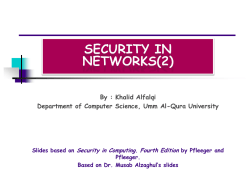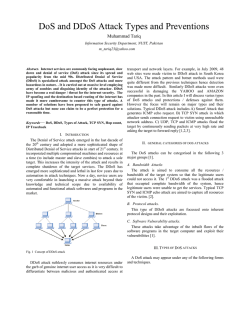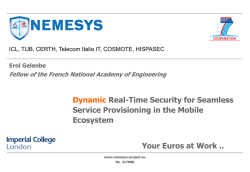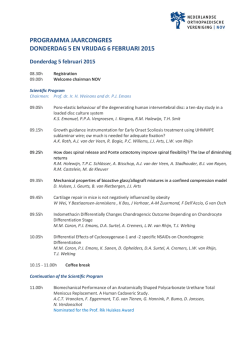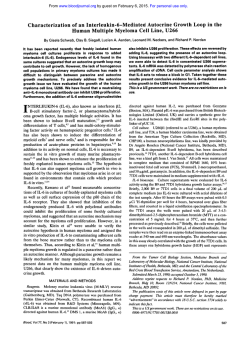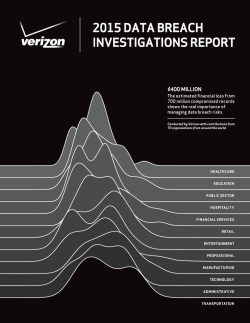
Cytokine Activation During Attacks of the
From www.bloodjournal.org by guest on February 6, 2015. For personal use only. Cytokine Activation During Attacks of the Hyperimmunoglobulinemia D and Periodic Fever Syndrome BY Joost P.H. Drenth, Marcel van Deuren, Johanna van der Ven-Jongekrijg, Casper G. Schalkwijk, and Jos W.M. van der Meer The hyperimmunoglobulinemia D and periodic fever (hyperIgD) syndrome is typified by recurrent febrile attacks with abdominal distress, joint involvement(arthralgias/arthritis), headache, skin lesions, and anelevated serum IgDlevel (>l00 U/mL). This familial disorder has been diagnosed in 59 patients, mainly from Europe. The pathogenesis of this febrile disorder is unknown, but attacks are joined by an acute-phase response. Because this response is considered t o be mediated by cytokines, we measured the acute-phase proteins C-reactive protein (CRP) and soluble t y p e 4 phospholipase A2 (PLA2)together with circulating concentrations and ex vivo production of the proinflammatory cytokines interleukin-la (IL-la), IL-Ip, IL-6, and tumor necrosis factor a (TNFa) and the inhibitorycompounds IL-l receptor antagonist flL-Ira). IL-10. and the soluble TNF receptors p55(sTNFr p551 and p75 (sTNFr p751 in 22 patients with the hyper-lgD syndrome during attacks and remission. Serum CRP and PLA2 concentrations were elevated during attacks (mean, 213 mg/L and1,452 ng/mL, respectively) and decreased between attacks. Plasma concentrations of IL-la, IL-lp, or IL10 were not increased during attacks. TNFa concentrations were slightly, but significantly, higher with attacks (104 v 117 pg/mL). Circulating IL-6 values increased with attacks (19.7 v 147.9 pg/mL) andcorrelated with CRP and PLA2values during the febriieattacks. The values of theantiinflammatory compounds IL-Ira, sTNFr p55, and sTNFr p75 were significantly higher with attacks than between attacks, and there was a significant positive correlation between each. The ex-vivo production of TNFa, IL-Ip, and IL-Ira was significantly higher with attacks, suggesting that the monocytes/macrophages were already primed in vivo t o produce increased amounts of thesecytokines. These findings point t o an activation of the cytokine network, and thissuggests that these inflammatory mediators may contribute to the symptoms of the hyper-lgD syndrome. 0 1995 by The American Societyof Hematology. T from a disturbed cytokine synthesis which may be responsible for some ofits clinical manifestationsand could also contribute to the polyclonal serum IgD elevation.’” Therefore, we studied the pattern of circulating and ex vivo production of inflammatorymediators 1L-la,IL-ID. IL-6, TNFa, C-reactive protein (CRP), soluble type-I1 phospholipase A? (PLA,), and inhibitory compoundssuch as IL-I receptor antagonist ( L l r a ) , IL-10, and soluble TNF receptors p55 (sTNFr p55) and p75 (sTNFr p7.5). HE HYPERIMMUNOGLOBULINEMIA D and periodic fever syndrome (hyper-IgD) is a rare entity characterized by periodic occurrence of febrile attacks.’ All patients have a clearly elevated (po1y)clonal serum IgD (> 100 U/mL). So far,wehavediagnosed 59 patients (31 male and 28 female) from nine, mainly European, countries. The episodes last 3 to 7 days, occur every 4 to 6weeks,start early, and persist throughout life, and, between attacks, patients are nonsymptomatic.’ Symptoms are not triggered by known infectiousagentsandincludeabdominaldistress (vomiting, diarrhea, and pain), joint involvement(arthralgia/ arthritis), skin lesions, headache, and lymphadenopathy. 2 ~ 4 The main feature of the disease is the abrupt onset of fever that parallels with an acute-phase reaction as evidenced by leukocytosis, neutrophilia, and a raised erythrocyte sedimentation rate. The pathogenesis of the hyper-IgD syndrome is unclear, but, because fever and the acute-phase reaction are considered to bemediated by cytokines such as interleukin- 1p (ILlo), IL-6, and tumor necrosis factor a (TNFa), it can be speculated that symptoms in the hyper-IgD syndrome result From the Department of Medicine, Division of General lnternal Medicine, University Hospital St Radboud, Nijmegen, The Netherlands. Submitted October 20, 1994; accepted February 4, 1995. J.P.H.D.isarecipient of U DutchOrganization f o r Scient$c Research fellowshipfor Clinical Investigators (KWO 900-716-065). Address reprint requests to Professor Jos W.M. Van der Meer, MD, Department of Medicine, Division of General Internal Medicine,UniversityHospital St Radboud,P.O. Box 9101, 6500 HB Nijmegen, The Netherlands. The publicarion costsof this article were defrayedin part by puge chargepayment. This article must thereforebeherebymarked “advertisement” in accordance with 18 U.S.C. section 1734 solely to indicate this fact. 0 1995 by The American Society of Hematology. 0006-4971/95/8512-0034$3.00/0 3586 MATERIALS AND METHODS Patients. Thestudygroupconsisted of 22 Dutch patients, 14 male and 8 female patients, with the hyper-IgD syndrome. Themean age at the time of the study was 28.3 years (SD ? 14.4 years). The diagnosis was made following standard clinical criteria, and a recent review with a pertinent description of the clinical and biologic features of thehyper-IgDsyndromehasbeen published elsewhere.’ recurrent febrileattacks Briefly, all patientsweresufferingfrom accompanied by a combination of the following features: lymphadenopathy,splenomegaly,arthralgiadarthritis,abdominalpainhorniting/diarrhea, and skin lesions. The attacks are self-limiting and last 3 to 7 days. The main clinical features of these patients are listed in Table 1. Bloodsamples. Samplingofplasma was performedduringattacks as well as during remission, using special endotoxin-free tubes NJ). The (Vacutainer Systems; Becton Dickinson, Rutherford, plasma was immediately processed to avoid ex vivo cytokine excre(238°C not caused tion.’ We defined attacks if the patient was febrile by infection) and showed signs of active disease with symptoms as mentioned before. Remission was defined as the absence of symptomsforat least 1 month. No medication,includingantipyretics, were allowed during the study period.All patients underwent physical examination, and results are listed in Table 1. Cytokine production was measured using a whole blood culture system as described 48 pL EDTA-KI elsewhere.” Briefly, two 4-mL tubes containing and 250 pL aprotinin ( 1 0,000 kallikrein-inactivating units per mL; Bayer, Leverkusen, Germany) were drawn. One tube was incubated immediately; the other tube was incubated after addition of SO p L lipopolysaccharide (LPS; Escherichia coli serotype OSS:BS, final concentration 10 pglmL;Sigma,StLouis. Blood, Vol 85, No 12 (June 15), 1995:pp 3586-3593 From www.bloodjournal.org by guest on February 6, 2015. For personal use only. CVTOKINES IN HYPER-IGD SYNDROME 3587 Table 1. Main Clinical Features of 22 Patients With the Hyper-lgD and Periodic Fever Syndrome Patient No. l 2 3 4 5 6 7 8 9 10 11 12 13 14 15 16 17 18 19 20 21 22 Age Sex F M M M F M M M F F M F F M M M M M M M F F (yr) 32 30 34 69 42 49 35 36 24 43 20 16 22 13 21 8 12 31 27 7 24 21 Lymphadenopathy Splenomegaly Abdominal Distress Skin Lesions Arthritis + + - + + + + + + + + + + + + + + - + + + + + + + + + + + + + + + + + + + - - + + - + + + + + + - + + - + - - + - - - + + + + - - - + + + + + + + + - - - + - + + + + + + + + + + + + + + + + + + t + - + + - Abbreviations: +, present: -, absent; M, male; F, female. MO). After 24 hours of incubation at 37°C both tubes are centrifuged at 2,250g for 10 minutes and, second, at 15,OOOg for 5 minutes to obtain platelet-poor plasma. Aliquots were stored at -70°C until assay. Cytokine production with LPS stimulation was measured and compared with production without LPS stimulation. Control values were obtained from 10 healthy volunteers (20 to 45 years of age) and were 6,847 2 2,175 pg/mL (IL-lP); 3,344 2 969 pg/mL (TNFa), and 9,827 2 2,597 pg/mL (IL-ha). TNFa was determined by radioimmunoassay as described by Van der Meer et all0 (lower detection level, 20 pg/mL; upper detection limit, 10,OOO pg/mL). IL- la and IL-Ip were measured by radioimmunoassay (without chloroform extraction) according to Lisi et a l l ’ (&la lower detection limit, 5 pg/mL; IL-lp lower detection limit, 40 pg/mL). IL-lra was determined by radioimmunoassay according to Poutsiaka et allz (lower detection limit, 60 pg/mL). sTNFr were measured by an enzyme-linked immunosorbent assay (ELISA [detection level, 80 pg/mL for sTNFr p55 and 300 pg/mL for sTNFr ~751;a kind gift of H. Gallati, Hoffmann-La Roche, Basel, Switzerland). This assay measures both free and total receptor-bound concentrations. Because sTNFr is not produced ex vivo, its LPS-stimulated production was not assessed in this study. IL-6 was measured by an ELISA as described earlier (detection level, 14 ~ g / m L ) . IL-10 ’~ was measured by sandwich ELISA with the 4G6 and 5D11 mouse antihuman IL10 monoclonal antibodies for capture and the 5A10 antihuman L - l 0 monoclonal antibodies for detection (kindly provided by Medgenix, Amersfoort, The Netherlands). The detection limit was 11 pg/mL.I4 CRP measurements were performed with an immunoturbidimetric assay using an automatic analyzer HITACHI 747 (Hitachi CO, Tokyo, Japan). The measuring range was from 3 to 440 mg/L. Secreted nonpancreatic type-I1 PLAl antigen concentrations in plasma were determined with an ELBA modified from Smith et aL5 Two different monoclonal antibodies against human PLAz (a kind gift from Dr F.B. Taylor, Jr. Oklahoma Medical Research Foundation, Oklahoma City, OK) were used as coating and catching antibodies. Because previous experiments showed a very good correlation between results from ELISA measurements and those obtained with cultured medium from Hepatoma G2 cells stimulated with hu- man IL-6, only the former method was used (Schalkwijk CG, unpublished observations). The lower limit of detection was 1 ng/mL. To minimize analytical errors, all samples from the same patient were analyzed in the same run in duplicate. Statistical analysis. The paired nonparametric Wilcoxon signed rank test was used for statistical comparison of values obtained during active disease versus remissions. The unpaired nonparametric Mann-Whitney U test was used where appropriate. In patients with multiple samples taken during separate episodes of active disease, the mean value was used. Probability ( P ) values were calculated on the basis of two-tailed tests, A correlation coefficient was calculated with the Pearson’s correlation test. A P value of less than .05 was considered to be the lowest level of significancy. Data are given in mean 2 standard deviation (SD). RESULTS Results of circulating cytokines and other inflammatory mediators are given in Figs 1 and 2. The CRF’ concentrations, a reflection of the acute-phase response, clearly modulated with the attacks in the patients with the hyper-IgD syndrome. The CRP concentrations were uniformly high during attacks (213.3 -C 98.2 mg/L) but decreased to low values (22.6 ? 26.8 mg/L) in between attacks ( P < ,0001; see Fig 1A). Concentrations of PLAz increased to amean of 1,452 ? 1,665 ng/mL during the febrile attacks, as compared with values during nonsymptomatic periods ( 1 13 2 240 ng/mL; P < .0001; see Fig 1B). One patient even had a 253-fold elevation (maximum, 6,066 ng/mL) of PLA2 during attack as compared with convalescence. The concentrations of PLAz and CRF’ obtained during febrile attacks showed a very good correlation during attacks ( r = 0.74; P < .OOOl). We could not detect measurable quantities of circulating IL-la between and during attacks in patients with the hyperIgD syndrome (Table 2). The mean plasma concentrations of IL-lP during active disease did not differ from the values From www.bloodjournal.org by guest on February 6, 2015. For personal use only. 3588 DRENTH ET AL 400 ? A B I aoo- :l 000 \ m S 100- :l00 4 Q 100- .l0 0 - 1 no .&h obtainedduring remissions. The TNFa concentrationsincreased from 104 ? 20 pg/mL to 1 17 + 15 pg/mL, a small but significant increase ( P = ,0075). Nevertheless, the TNFa concentrations during attack remained within normal values 25 pg/mL). IL-6 was also signifiof our laboratory (106 I cantly elevated during active disease (147.9? 258.3 pg/mL; P < .0001; see Fig 2A). Three patients hadvalues above 150 pg/mL (471, 720, and 1,074 pg/mL, respectively). Exclusion of data from these 3 patients did result in a lower mean IL-6 plasma concentration during attacks (54.9 + 27.2 pg/mL). However, the difference betweenvaluesobtained during attacks and between attacks remained significant despite exclusion ( P < .0001). During febrile episodes, there was a moderate, albeit significant, correlation between IL-6 and the acute-phase proteins CRP ( r = 0.47; P = .014) and PLA2 ( r = 0.45; P = ,018). No correlation could be detected between IL-6 and either IL-10 or TNFa. IL-IO, measured in plasma of8patients, remained unchanged regardless of the phase of the disease (Table 2). The anti-inflammatory compounds IL-Ira, sTNFr p55,and sTNFr p75 were significantly increased during attacks compared with remissions (Fig 2B through D). The mean values of IL-lra were 996 ? 329 pg/mL during attacks, whereas 167 pg/mL during remission ( P < .0001; they were 300 see Fig 2B). Themean sTNFr p55 and sTNFr p75 concentrations during active disease increased to 5,043 ? 1,703 pg/ mL and 7,103 ? 2,378 pg/mL, respectively (both P < .0001; see Fig 2C and D). The sTNFr p7YsTNFr p55 ratio did not change withattacks (data not shown). We could not establish a correlation between either the individual concentrations of IL-Ira, sTNFr p55, or sTNFr p75 and the temperature at the time of blood drawing or the frequency of the attacks (data not shown). During attacks, there was a significant correlation between circulating plasmaconcentrations of IL-Ira and sTNFr p55 ( r = 0.48; P = .0231), IL-Ira and sTNFr p75 (Y + Fig 1. Individual serum CRP (A) and PLAz (B) for 22 hyper-lgD patients during and in between attacks. For (A), the vertical lines indicate mean ( 0 )2 SD. The vertical lines in (B) indicate median and 95% confidence intervals. The increase was statistically significant for CRP and PIA2 ( P c .0001). = 0.67; P = .0006), and sTNFr p55 and sTNFr p75 (r = 0.58; P = ,0041); however, no correlation could be detected between individual CRP levels and IL-Ira, sTNFr p55, or sTNFr p75 levels. In 3 patients, the course of the circulating IL-Ira, sTNFr p55, and sTNFr p75 concentrations during the first 5 days after onset of the attack was followed as shown in Fig 3. The course of values for the various cytokines is as follows. sTNFr p55 and sTNFr p75 only decrease 3 days after onset of the febrile attack. IL-lra reaches the highest values on the second dayof the attack and normalizes within 5 days. IL-6 was rapidly cleared from thecirculation, similar to the acute-phase proteins CRP and PLA2. Ex vivo cytokine production. Figure4,upperpanel, shows thenonstimulated production of the various cytokines tested. The unstimulated production of TNFa between attackswas significantly higher as compared withthat for healthy controls (564 5 304 v 225 ? 11 pg/mL). Only the values for IL-lra were significantlyhigher during attacks than during remissions, 3,642 2 1708 pg/mL as compared with 2,048 ? 2,398 pg/mL ( P = .015). The productionof IL- la in whole blood in the presence or absence of LPS was negligible and did not differbetween attacks and remission. The LPS-stimulated production of I L - l p and TNFa in patients with the hyper-IgD was significantly higher during attacks as compared with that in remissions and for healthy controls (Fig 4, lower panel; P < .0001).During remissions, both the unstimulated and LPS-stimulatedproduction of TNFa, but not of IL-Ip, was significantly higher compared with that of controls ( P < .OS). Fourteen patients had TNFa concentrations beyond the upper detection limit of 10,000 pg/mL during attacks, compared with only 6 patients during remission. LPS-stimulated productionof IL-6 during attacks was similar to that measured during nonsymptomatic periods. The LPS-stimulated production of IL-lra was also significantly higher during attacks than in between attacks and than that in healthy volunteers ( P < .0001). From www.bloodjournal.org by guest on February 6, 2015. For personal use only. 3589 CYTOKINES IN HYPER-IGD SYNDROME - 1600 -1000 a 2 !! .- A l I 104 a m -600 .((.drn.#k 1 - 1 10000 16000 C D 11.600 ~000 -10000 10 Fig 2. Circulating 11-6 (A), ILI r a (B), sTNFrp55(C),andsTNFr p75 (D) in 22 hyper-lgD patients. The individual values are represented by blackdotsand were obtained during andbetween attacks. In (A), the vertical lines indicate median ( + I and 95% confidence intervals. For (B through D), the verticallinesare the was mean (01 ? SD. The increase statistically significant for all four cytokines ( P c .00011. -7600 16 p e5 4000 two I -6000 a 2 10 a !i a -2600 0 During attacks, there were modest correlations between IL-lra and IL-l@production ( r = 0.42; P = .027) and ILIra and L - 6 production ( r = 0.3; P = .027). The production of IL-1@ correlated wellwith that of L - 6 during febrile episodes (I = 0.53; P = .0057). DISCUSSION We investigated the pattern of circulating cytokines and the ex vivo production of cytokines in 22 patients with the hyper-IgD syndrome. We found evidence for a vigorous acute-phase response in the hyper-IgD syndrome, as reflected by the significant increase of CRP and PLAl concentrations that subsided during remission. The significant ele- vation of the proinflammatory cytokines IL-6 and, albeit very modest, TNFa together with the elevation of the natural cytokine inhibitors IL-lra, sTNFr p55, and sTNFr p75 point to activation of the cytokine network during the attacks of the hyper-IgD syndrome. Although it is not clear to what extent these cytokines contribute to the clinical features of the hyper-IgD syndrome, many of its symptoms are compatible with the effects of proinflammatory cytokines. However, it is unlikely that only one factor can cause the clinical picture; instead, activation of the cytokine network and involvement of various cytokines probably contribute to the pathogenesis of the attacks. The elevation of these inflammatory mediators occurs re- From www.bloodjournal.org by guest on February 6, 2015. For personal use only. 3590 DRENTH ET AL 10 and TNFa may be thedelay between onset of attack and sampling. Although we sampled all our patients on their first day with fever, thismayalready have been toolate. The Circulating Concentration (pg/mL) 2 SD slight elevation of TNFa during attacks perhapsreflects the Cytokine Between Attacks Attack descendingslope of an earlierpeak. The increased CRP IL-Iff 15 <5 levels at time of drawing of blood indicate an already ongoIL-IP 83.1 f 20.3 80.4 2 21.6 ing acute-phase response thought to be the consequence of IL-IO* 20.3 2 21.1 14.8 2 3.7 the action of cytokines, and these may have already disap* Tested in 8 patients. peared from the circulation. This hypothesis is in line with the finding of increased cytokine inhibitors such as IL- Ira, sTNFr p55, andsTNFrp75, of which it isknown.from experimental endotoxemia, that they can still be detected in gardless of the severity of attacks, as reflected by body temthe circulation hours after the disappearance of IL-Io and perature and CRP concentrations the or frequency of attacks. TNFmZ5-” The sameholds for PLA2, which peaks l8 to 24 The absenceof any elevationof IL- 10 concentration, a potent hourslaterthan TNFa after endotoxin infusion in human inhibitorof synthesis of cytokines, argues against an imvolunteers.2x portant roleforthiscytokine in the pathogenesis of the In our study, elevation of IL-lra, sTNFr p55, and sTNFr hyper-IgD syndrome.I6Lastly, there isincreased exvivo p75 was present at the first day of an attack, and appreciable production of IL-lp, TNFa,and L - l r a during attacks comconcentrations were found on the second and third day of pared with nonsymptomatic periods,as measured in a whole the attack. Endogenously produced IL-Ira, a major natural blood culture system. inhibitor of IL-1, may ameliorate the severity of attacks in The acute-phase response in humans is considered to be mediated by theproinflammatory cytokines, and we detected the hyper-IgD syndrome.29-” Because we did not find clear elevations of IL-1 concentrations, it is impossible to judge a modest but significant elevation of IL-6 together with a whether the amount of IL-lra is adequate to alleviate the significant correlation between IL-6 and the acute-phase proacute inflammation. Our finding of predominant concentrateins CRP and PLA2 in the blood during the febrile attacks. tions of IL-1 antagonist recalls the results obtained in sysIn view of these findings,it can be speculatedthatthe temic JRA, another periodic febrile disorder. In JRA, inhibiincreased plasma IL-6 concentration results from overprotion of IL-l bioactivity by serum andurine during febrile duction rather than underutilization, because renal function attacks was found.?’ Also, for TNFa, we merely find inhibiwas normal in allpatients. In addition, the elevated IL-6 tion, as judged by the elevated concentrations of soluble values are associated with increased CRP and PLA2values. receptors for TNF.’3 sTNFrs bind TNF and forma biologic, Underutilization would probably have resulted in low coninactive complex, blunting the deleterious effectsof TNFa.” centrations of these acute-phase proteins. IL-6, as the major How do ourresults of circulating cytokines comparewith mediator for the regulation of acute-phase protein synthesis measurements in another periodic fever syndrome such as in humans, also influences the glycosylation of these proteins.7.~7,~a In recent studies in the hyper-IgD syndrome, we familial Mediterranean fever (FMF)? In FMF patients, TNF and IL-I activity has been investigated. have shown elevated a1-3 fucosylation of the acute-phase In a study with Sephardic Jews with FMF there was no protein a,-acid glycoprotein (AGP), and this finding is comevidence of TNFa bioactivityin plasma obtained during patible with a role of IL-6 during the recurrent febrile atattack and remi~sion.’~Nevertheless, the investigators sugtacks.” In addition, IL-6 is a stimulus for PLA2 synthesis in lackof gesteda roleforTNFa in FMFandimputethe the liver, and thestrongly elevated (1 3-fold) PLA2 concentraelevated circulating plasma TNFa to the short half life (6 tions found during the febrile attacks, together with the correminutes) and the possible binding to soluble receptors. In a lation between IL-6 and PLA2, corroborate with these findings.” By cleavage of arachidonic acid from cell membrane, similar study of Turkish FMFpatients, using ELISA, TNFa was detected, albeit in modest concentrations (33.1 pg/mL PLA2 in its turn is able to elicit an inflammatory response. in betweenattacks compared with 62.2pg/mLduringatEnhanced PLA2 activity in serum propagates tissue damage tacks).’s Here,again, one maywonderwhetherthevalues through membrane digestion and liberation of cytotoxic fatty measured during an attack represent a tail of initially elevated acids?’ For example, when administered intra-articulary in TNF concentrations. Thehigherconcentrationswe found rats,it causes synovitis:* and serum PLA’ concentrations (104 5 20 pg/mL) and attacks ( 1 17 -+ I5 during remissions correlate well with activity of juvenile rheumatoid arthritis pg/mL) in the hyper-IgD syndrome are most likely due to (JRA)in human^.'^ Furthermore,intradermal injection of detection of both free TNF and TNF bound to sTNFr. PLA2 causes local dermal inflammatory infiltrate^.'^ These The role of IL-1 was tested in a study of 18 FMF patients, biologic effects of PLA2 may be responsible for some of the 9 symptomatic and 9 asymptomatic, and mean IL- 1 activity clinical featuresof the hyper-IgD syndrome, because arthritis in patients (either during attack or remission) was comparaand cutaneousvasculitis are main symptoms of the disease.’,’ ble with the values obtained in controls.’* Despite our efforts, we have not been able to establish We studiedthe effect ofbacterial LPS on the cytokine which endogenous pyrogen is responsible for the fever in productionasgeneratedin whole blood. In contrast to Tthe hyper-IgD syndrome. A possible reason for our failure to trace appreciable ele- cell mitogens such as concavalin A, in our experience, LPS is a reliable stimulator of cytokine production. The effect of vations of pyrogenic proinflammatory cytokines such as ILTable 2. Circulating Cytokinas in 22 Patients With Hyper-lgD Syndrome From www.bloodjournal.org by guest on February 6, 2015. For personal use only. 3591 CYTOKINES IN HYPER-IGDSYNDROME 1 a00 1090 ..e 000 400 .a00 0 Do00 10.0 DO00 10.0 a000 *ooo a000 1000 0 0 a00 a000 F 800 l000 0 B Fig 3. Time courseof circulating concentrationsof 11-6 (Al. ILlra (B), sTNFr p55 (C),sTNFr p75 (D), CRP (E),and PLA, (F) in 3 individual patientswith the hyperigD syndrome during the first 5 days of an attack. 1000 109 000 00 0 LPS is dose-dependent, and dosages at 10 &mL as used in our study have yielded reproducible result^.^' It is of interest that we detected an augmented LPS-stimulated ex vivo production of TNFa, E-lP, and IL-lra in our whole blood culture system during attacks. This enhanced production capacity in the hyper-IgD syndrome during attacks is in contrast with findings obtained in various infectious diseases such as meningococcal sepsis and typhoid fever, where the ex vivo production of TNF, IL-1, and IL-6 is depressed during the acute stage and is gradually restored during r e ~ o v e r y . ~ ' . ~ ~ Also, TNFa and IL-1 production, as stimulated by LPS, 0 has been reported to be markedly decreased during attacks in ~ ~ . 3 4 , 3 6 . 4We 0 could confirm these results in three Fh4F patients and detected decreased ex vivo production of TNFa, IL-lP, and IL-lra during attacks (Drenth JPH, unpublished observations). These findings clearly differ from the increased production during the febrile attacks of the hyperIgD syndrome. It is possible that the monocytes/macrophages in the hyper-IgD syndrome are already primed in vivo to produce increased amounts of these cytokines. This could be the result of increased concentrations of AGP and CRP,because these acute-phase proteins have been shown to potentiate the in vitro production of cytokines and of From www.bloodjournal.org by guest on February 6, 2015. For personal use only. 3592 DRENTH ET AL 6000 t- tional Hyper-IgD Study Group: Hyperimmunoglobulinemia D and periodicfever.Theclinicalspectrum in aseries of SO patients. 5000 Medicine (Baltimore) 73:133. 1994 3 . Drenth JPH. Boom BW, Toonstra J, Van der Meer JWM. and 4000 the International Hyper-IgD Study Group: Cutaneous manifestations M a 3000 andhistologicfindings in thehyperimmunoglobulinemiaDsyndrome. Arch Dermatol 1.3059. I994 2000 4. Loeliger AE, Kruize AA. Bijlsma JWJ, Derksen RHWM: Ar1000 thritis in hyperimmunoglobulinemia D. Ann Rheum Dis S2:81, 1993 S. Baumann H. Gauldie J: The acute phase response. lmmunol 0 IL-la IL-1D TNF IL-lra IL-6 Today IS:74, 1994 6 . Steel DM. Whitehead AS: Themajoracute phase reactants: C-reactive protein. serum amyloid P component and serum amyloid A protein. lmmunol Today 1S:XI. 1994 7. Van Dijk W, Turner CA. MackiewiczA: Changes in the glycosylation of acute-phase proteins in health and disease: Occurrence. ** regulation and function. Glycosyl Dis 1:s. 1994 30000 T X. Cannon JG. Nerad JL. Poutsiaka DD. Dinarello CC: Measuring circulating cytokines. J Appl Physiol 75: 1897. 1993 20000 9. Van Deuren M, van der Ven-Jongekrijg. Keuter M. Demacker 3 ". PNM, Van derMeerJWM:Cytokineproduction in whole blood M a cultures. J Int Fed Clin Chem S:216, 1993 10000 10. Van der Meer JWM. Endres S. Lonnemann G. Cannon JG. lkejima T, Okusawa S. Gelfand JA, Dinarello CA: Concentrations of immunoreactive human necrosis factor alpha produced by human n I L - l a IL-1D TNF IL-6 IL-lra mononuclear cells in vitro. J Leukoc Biol 43216. 1988 I I . Lisi PJ. Chu CW. Koch CA, Endres S. Lonneman G. DinaFig 4. Unstimulated fupperpanel) and net LPS-stimulatedproducrello CA: Development and use of radio immunoassay for human tion flower panel) of IL-la, IL-lp, TNFa, IL-6, and IL-lra in a whole interleukin-113. Lymphokine Res 6:229. 1987 blood culture system incubated for 24 hours. Data are shown as the 12. Poutsiaka DD. Clark BD, Vannier E. Dinarello CA: Producmean -C SD and are derived from experiments with 22 hyper-lgD tion of interleukin-l receptor antagonist and interleukin-lo by pepatients during (0)and in between attacks (a)and in 10 healthy ripheral blood mononuclear cells is differentially regulated. Blood volunteers (0).'P < .05 compared with healthy controls; "P < .05 compared with values obtained between attacks. 78: 127s. 199 I 13. Barrera P, Boerbooms AMT. JanssenEM,SauerweinRW, Gallati H, Mulder J. De BooTh,Demacker PNM. Van de Putte LBA. Van der Meer JWM: Circulatingsoluble tumor necrosis factor TNFa in parti~ular.".'~In addition. CRP and, to lesser exreceptors, interleukin-2 receptors, tumor necrosis factor a. and intent, AGP are able to induce the synthesis of IL-I ra in vitro.'? terleukin-6levels in rheumatoidarthritis.Longitudinalevaluation We have shown earlier that serum AGP concentrations are duringmethotrexateandazathioprine therapy. Arthritis Rheum markedly elevated during attacks of the hyper-IgD syndrome 36: 1072, I993 and are somewhat elevated during remission." In contrast. 14. MarchantA,Devitre J, By1B.De Groote D. Vincent JL. lower concentrations of the acute-phase protein AGP are sepsis. Lancet Goldman M: Interleukin- 10 production during found in FMF, and this perhaps contributes to the diminished 343:707. 1994 15. Smith GM. Ward RL, McGuigan L, Rajkovic IA. Scott K F LPS-stimulated cytokine production.w These dataunderMeasurement of human phospholipase A2 in arthritis plasma using score differences in pathogenesis of the disorders. Elsea newly developed sandwich ELISA. Br J Rheumatol 31:17S. 1992 where, we have already alluded to the geneticdifferences 16. De Waal Malefyt R, Abrams J. Bennett B, Figdor CC. De between FMF and the hyper-IgD syndrome."' Additional Vries JE: Interleukin-IO(IL-IO) inhibits cytokine synthesis by human studies are needed to further elucidate the role of the acutemonocytes: An autoregulatory role of IL-I 0 produced by monocytes. phase proteins in cytokine regulation inthe periodic fever J Exp Med 174:1209. 1991 syndromes and to delineate the molecular basis of the fever. 17. CastellJV,Andus T. Kunz D. Heinrich PC: Interleukin-6. The major regulator of acute-phaseprotein synthesis in man and rat. ACKNOWLEDGMENT Ann N Y Acad Sci SS7:87. 1989 We are indebted to GerardPesmanandMarielleSpruytenburg 18. Pos 0. Moshage HJ, Yap SH, Snieders JPM. AardenLA. Van (Laboratory of Endocrinology and Reproduction, University HospiCool J. Boers W, Brugman AM, Van Dijk W: Effect of monocytic tal St Radboud. Nijmegen, The Netherlands) for the analysis of ILproducts. recombinant interleukin- I , and recombinant interleukinla, IL-Io. TNFa,and IL-Ira. We are grateful toMarie-CCcile Dek6 onglycosylation of a,-acid glycoprotein:Studies with primary ker for her help with collecting the sera. hepatocyte cultures and rats. Inflammation 13:41S. 1989 19. Havenaar EC, Drenth JPH. Van Ommen ECR. Van der Meer REFERENCES JWM, Van Dijk J: Glycosylation of a,-Acid glycoprotein in hyperI . Van der Meer JWM. Vossen JM, Rad1 J, Van Nieuwkoop JA, immunoglobulinemia D and periodic fever syndrome. Evidence for Meyer CJLM, Lobatto S. Van Furth R: Hyperimmunoglobulinemia persistentinflammation. Clin lmmunollmmunopathol 1995 (in D and periodic fever: A new syndrome. Lancet I : 1087. 1984 press) 2. Drenth JPH, Haagsma CJ,Van der Meer JWM, and the Interna20. Crow1 RM. Stoller TJ. Conroy RR, StonerCR:Induction . 2 1 ** I From www.bloodjournal.org by guest on February 6, 2015. For personal use only. CYTOKINES IN HYPER-IGD SYNDROME of phospholipase A2 gene expression in human hepatoma cells by mediators of the acute phase response. J Biol Chem 266:2647, 1991 21. Pruzanski W, Vadas P: Phospholipase A2.A mediator between proximal and distal effectors of inflammation. Immunol Today 12:143, 1991 22. Vadas P, Pruzanski W, Kim J, Fornasier V: The proinflammatory effect of intra-articular injection of soluble human and venom phospholipase Al. Am J Path01 134:807, 1989 23. Pruzanski W, Albin-Cook K, Laxer R, MacMillan J, Stefanski E, Vadas P, Silverman ED: Phospholipase A2 in juvenile rheumatoid arthritis: Correlation to disease type and activity. J Rheumatol 21:1951, 1994 24. Pruzanski W, Vadas P, Fornasier V: Inflammatory effect of intradermal administration of soluble phospholipase A2 in rabbits. J Invest Dermatol 86380, 1986 25. Spinas GA, Bloesch D, Kaufmann M T , Keller U, Dayer JM: Induction of plasma inhibitors of interleukin 1 and TNF-cr activity by endotoxin administration to normal humans. Am J Physiol 259:R993, 1990 26. Van Zee W, Kohno T, Fischer E, Rock CS, Rock GS, Moldawer LL, Lowry S F Tumor necrosis factor soluble receptors circulate during experimental and clinical inflammation and can protect against excessive tumor necrosis factor (Y in vitro and in vivo. Proc Natl Acad Sci USA 89:4845, 1992 27. Granowitz EV, Santos AA, Poutsiaka DD, Cannon JG, Wilmore DW, Wolff SM, Dinarello CA: Production of interleukin-lreceptor antagonist during experimental endotoxaemia. Lancet 338:1423, 1991 28. Pruzanski W, Wilmore DW, Suffredini A, Martich GD, Hoffman AG, Browning JL, Stefanski E, Sterny B, Vadas P Hyperphospholipasemia A2 in human volunteers challenged with intravenous endotoxin. Inflammation 16561, 1992 29. Dinarello CA: Interleukin-l and interleukin-l antagonism. Blood 77:1627, 1991 30. Dinarello CA, Thompson RC: Blocking IL-1: Interleukin 1 receptor antagonist in vivo andin vitro. Immunol Today 12:404, 1991 3 1. Arend W P : Interleukin 1 receptor antagonist. A new member of the interleukin 1 family. J Clin Invest 881445, 1991 32. F’rieur AM, Kaufmann MT, Griscelli C, Dayer JM: Specific interleukin-l inhibitor in serum and urine of children with systemic juvenile chronic arthritis. Lancet 2:1240, 1987 33. Van Deuren M, Dofferhof ASM, Van der Meer JWM:Cytokines and the response to infection. J Pathol 168:349, 1992 3593 34. Schattner A, Lachmi M, Livneh A, Pras M: Tumor necrosis factor in familial Mediterranean fever. Am J Med 90:434, 1991 35. Ozylikan E, Simsek H, Telatar H: Tumor necrosis factor in familial Mediterranean fever. Am J Med 92579, 1992 (letter) 36. Rozenbaum M, Katz R, Rozner I, Pollack S: Decreased interleukin 1 activity released from circulating monocytes of patients with familial Mediterranean fever during in vitro stimulation by lipopolysaccharide. J Rheumatol 19:416, 1992 37. Nerad J, Griffiths JK, Van der Meer J W M , Endres S, Poutsiaka DD, Keusch GT, Bennish M, Salam MA, Dinarello CA, Cannon CA: Interleukin-1/3(IL-lP), IL-I receptor antagonist and TNFcr production in whole blood. J Leukoc Biol 52:687, 1992 38. Van Deuren M, Van der Ven-Jongekrijg J, Demacker PNM, Bartelink AKM, Van Dalen R, Sauerwein RW, Gallati H, Vannice JL, Van der Meer JWM: Differential expression of proinflammatory cytokines and their inhibitors during the course of meningococcal infections. J Infect Dis 169:157, 1994 39. Keuter M, Dharmana E, Hussein Gasem M, Van der VenJongekrijg J, Djokomoeljanto R, Dolmans WMV, Demacker P, Sauenvein R, Gallati H,Van der Meer JWM: Patterns of proinflammatory cytokines and inhibitors during typhoid fever. J Infect Dis 169:1306, 1994 40. Schattner A The reply. Am J Med 92580, 1992 (letter) 41. Boutten A, Dehoux M, Deschenes M, Rouzeau JD, Bories PN, Durand G: @,-Acidglycoprotein potentiates lipopolysaccharideinduced secretion of interleukin-1 8, interleukin-6 and tumor necrosis factor-cr by humanmonocytes and alveolar and peritoneal macrophages. Eur J Immunol 22:2687, 1992 42. Ballou SP, Lozanski G: Induction of inflammatory cytokine release from cultured human monocytes by C-reactive protein. Cytokine 4361, 1992 43. Tilg H, Vannier E, Vachino G, Dinarello CA, Mier W: Antiinflammatory properties of hepatic acute phase proteins: Preferential induction of interleukin 1 (IL-l) receptor antagonist over IL-lP synthesis by human peripheral blood mononuclear cells. J Exp Med 178:1629, 1993 44. Mellinkhof SM, Snodgrass RW, Schwabe AD, Mead JF, Weimer HE, Frankland M: Familial Mediterranean fever. Plasma protein abnormalities, low fat diet, and possible implications in pathogenesis. Ann Intern Med 56: 171, 1962 45. Drenth JPH, Mariman ECM, Van der Velde-Visser SD, Ropers HH, Van der Meer JWM: Location of the gene causing hyperimmunoglobulinemia D and periodic fever syndrome differs from that for familial Mediterranean fever. Hum Genet 94:616, 1994 From www.bloodjournal.org by guest on February 6, 2015. For personal use only. 1995 85: 3586-3593 Cytokine activation during attacks of the hyperimmunoglobulinemia D and periodic fever syndrome JP Drenth, M van Deuren, J van der Ven-Jongekrijg, CG Schalkwijk and JW van der Meer Updated information and services can be found at: http://www.bloodjournal.org/content/85/12/3586.full.html Articles on similar topics can be found in the following Blood collections Information about reproducing this article in parts or in its entirety may be found online at: http://www.bloodjournal.org/site/misc/rights.xhtml#repub_requests Information about ordering reprints may be found online at: http://www.bloodjournal.org/site/misc/rights.xhtml#reprints Information about subscriptions and ASH membership may be found online at: http://www.bloodjournal.org/site/subscriptions/index.xhtml Blood (print ISSN 0006-4971, online ISSN 1528-0020), is published weekly by the American Society of Hematology, 2021 L St, NW, Suite 900, Washington DC 20036. Copyright 2011 by The American Society of Hematology; all rights reserved.
© Copyright 2025
